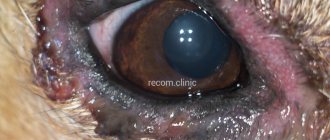The period of gestation of puppies is an important stage in the life of a dog and its owner. You need to carefully monitor any changes in the animal's condition. The temperature of a pregnant dog deserves special attention.
It is worth finding out in advance what indicators are considered normal, and when you need to immediately seek help from a veterinarian.
Normal indicators
Normal body temperature in dogs varies between +37.5…+38.8°C. A decrease or increase in these indicators signals disruptions in the body and the development of the disease.
A short-term increase is observed under the influence of the following factors:
- hot weather;
- intense physical activity;
- stress.
Soon the condition will return to normal. Prolonged hyperthermia is an alarming symptom.
Such problems are provoked by a number of pathologies:
- allergic reaction;
- plague;
- endometritis;
- piroplasmosis.
A decrease in temperature is possible with helminthic infestation, before childbirth.
Normal body temperature for a pregnant dog
Just like in humans, an increase or decrease in body heat in dogs most often indicates some kind of disease or disorder in the body.
Temperature may rise for a short period in hot weather, after intense physical exertion, stress (visiting a doctor). However, in this case, she quickly returns to normal.
In the case of prolonged hyperthermia in dogs, you need to pay close attention to this, because this can be a signal of serious diseases - distemper, piroplasmosis, endometritis, allergies, abscess, inflammation of the joints.
A decrease is observed with helminthic infestation, parvovirus enteritis in puppies, and also before childbirth in bitches. We will dwell on the latter reason in more detail in the following sections.
It is believed that the temperature should be measured regularly in puppies, and in adults if the dog is sick or pregnant, before and after childbirth.
In other cases, this can be done as needed. IMPORTANT! For hygiene reasons, you should not use the same thermometer that is used to measure people's temperatures.
How to try on
Measurements must be made with a specially designed mercury or electronic thermometer for the animal.
The procedure is not complicated, however, it will require some skill from the owner. You need to reset the thermometer readings, lubricate its tip with Vaseline, put the dog on its side, calm it down and carefully insert it 1-2 cm into the animal’s anus.
It is possible to measure the dog's temperature while it is standing, but it will be more difficult for an inexperienced owner to do this . When using an electronic thermometer, you need to wait 1 minute, but if the thermometer is mercury, you will have to hold it for 3 to 5 minutes.
ATTENTION! It is very important to create a calm atmosphere for the dog from the first measurement and ensure that the procedure is painless. You can reward the animal with a treat. If the training for this procedure has been completed correctly, the dog will not be afraid or resist, and it and the owner will be comfortable measuring the temperature in the future.
Otherwise, the dog may begin to twitch and squirm , which is why the thermometer will probably break and injure the animal or person, not to mention the fact that the temperature will never be measured.
What is considered the norm? Thus, the following temperature indicators for puppies :
- small breeds – 38.6-39.3˚С
- medium breeds – 38.3-39.1˚С
- large breeds – 38.2-39.0˚С
and for adults :
- small breeds – 38.5-39.0˚С
- medium breeds – 37.5-39.0˚С
- large breeds – 37.4-38.3˚С
Pregnancy of bitches in itself should not introduce changes in the values of the measured temperature. Normally, it corresponds to the above standards depending on the size of the dog. However, it is possible that it may increase or decrease if any problems or diseases arise . Only if the dog is pregnant and before giving birth, according to your calculations, approximately about a day, its sharp decrease is physiological.
The need to maintain a schedule
Veterinarians recommend measuring a pregnant dog’s body temperature at least once a week.
The procedure should be carried out even if there is no change in the pet’s condition. When your dog's behavior becomes unnatural, you should immediately consult a doctor.
A week before the expected birth, the breeder needs to start keeping a schedule. The measurement results are entered there.
The procedure is carried out twice a day - morning and evening. Thanks to such actions, it will be possible to accurately record the moment when a sharp decrease in the indicator occurs.
Having noticed such changes, the owner needs to prepare for childbirth and postpone all matters. The animal will need his help. It would be a good idea to call a veterinarian or an experienced dog breeder for help.
How to determine the beginning of labor in a dog?
Determining the exact date of birth can be difficult, since a dog’s pregnancy can last from 57 to 72 days from the first mating. The duration of pregnancy is much more predictable when the date of ovulation is known. In this case, labor will begin on days 62–64 from the day of ovulation.
Ultrasound can help determine the number of days until delivery by measuring the biparietal diameter of the fetal head and using a special calculation formula for dogs of different sizes.
From the 42nd day of pregnancy, the fetal skeleton becomes visible on radiographs, from the 45-49th day the skull bones are visualized, from the 57-59th day - the pelvic bones, from the 58-63rd day - the teeth.
2-7 days before giving birth, dogs may begin to show symptoms of excitability, restlessness, nesting, increased urination and defecation, and decreased appetite.
This is due to a gradual increase in uterine contractions. On the day of birth, there may be no appetite at all.
Breast enlargement begins in the second half of pregnancy. Lactation in some bitches appears from the 40th day of pregnancy, in some immediately before, during, or immediately after childbirth.
An increase in the concentration of the hormone relaxin in the blood leads to an increase and softening of the loop (0–2 days before birth), relaxation of the cervix and, as a consequence, separation of the mucous plug (0–7 days before birth).
A drop in body temperature before parturition is a reliable indicator of the onset of labor in dogs, reflecting a rapid drop in blood levels of the hormone progesterone below 1 ng/ml, a thermogenic hormone that maintains pregnancy. Body temperature drops sharply (to approximately 36.7–37.7 degrees).
Subscribe to our newsletter and get a free veterinary consultation
Thanks for subscribing!
You should know that after the fall, the temperature will rise slightly (to about 37.2 degrees) and will be maintained throughout the first stage of labor. At this time, there are 8–24 hours left until the first puppy appears.
It is recommended to start measuring rectal temperature from the 54th–55th day of pregnancy 1–2 times a day at the same time.
A slight decrease in body temperature may be observed in the last week of pregnancy, as the level of progesterone in the blood gradually decreases. However, in some dogs this method fails to detect the moment of temperature drop.
The rupture of the first amniotic sac, the flow of yellow-green discharge (water) from the external genitalia indicates the separation of the placenta and the beginning of the second stage of labor (the stage of pushing - expulsion of the fetus); and there are 1–2 hours left until the first puppy appears.
How to measure
Measuring an animal's temperature is easy. An electronic or mercury thermometer is used.
The following manipulations are performed:
- The thermometer readings are reset to zero.
- The tip is lubricated with Vaseline.
- The pet is placed on its side and calmed down.
- The thermometer is inserted into the anus to a depth of about 2 cm.
- The electronic thermometer is held for 1 minute, the mercury thermometer for 5 minutes.
The option of measuring when the dog is standing is allowed. But for inexperienced dog breeders, measuring indicators in this way is problematic.
When performing the procedure for the first time, it is important to create a comfortable environment for the pet and reward it with treats..
If everything is done correctly, the animal will be calm about such manipulations. If discomfort is caused once, it will be difficult to measure body temperature in the future because the dog remembers the pain.
What you need to know before your dog goes into labor
To novice “dog breeders” – absolutely all dogs have a genetic memory of behavior during childbirth. If there are no complications, the dog will give birth completely on its own. Pets that are “problematic” in terms of breeding require mandatory “accompaniment” during childbirth.
Whether to seek help from veterinarians or zoo obstetricians is the owner’s choice. However, if at least one of the points below applies to you or your ward, contact the nearest clinic; even a novice veterinarian can give birth to a dog.
- You are the owner of a dog and are afraid of blood, you are squeamish, you fall into a “stupor” in an emergency situation, you do not understand the “mechanics” of childbirth, you do not know how to provide emergency care, you have never delivered an animal, you are overly excited, your pet does not trust you.
- The dog has dysplasia - the hip region is incorrectly formed.
- The dog has heart problems, or his closest genetic relatives had them.
- Expecting 6 or more puppies can be determined using an ultrasound.
- Miniature breeds and mixed breeds.
- The dog had a caesarean section during a previous pregnancy.
Even the most inexperienced dog owner can prepare for childbirth with the help of literature and videos. As practice shows, it is not experience that is important, but self-confidence and moral readiness of the owner.
Changes during labor
At the first stage, contractions appear. The woman in labor often begins to stagger and shortness of breath appears. Even vomiting is possible. The pet refuses food. The duration of the stage is about 12 hours. Sometimes contractions drag on for up to a day and a half.
It is extremely important to measure your temperature systematically. The normal course of labor is characterized by a consistently reduced rate.
Frequent contractions lead to anxiety in the animal. The dog gets very excited and scratches the bedding. The vagina begins to relax, and the cervix dilates.
The reproductive organ periodically contracts. Towards the end of the first stage, contractions become more frequent and more intense.
At the beginning of the second stage, normalization of thermometer readings is noted. The waters are receding. The abdominal muscles tense. The cervix is completely opened. The fetus ends up in the birth canal. The abdominal muscles contract as often as possible. The appearance of attempts is recorded. After this, the puppy is born.
The baby appears in a bubble. The dog breaks the shell on its own. If the bitch refuses this, human help is needed, otherwise the puppy will die.
The final labor stage lasts about 4-6 hours. The afterbirth is coming off. There should be exactly as many of them as puppies were born.
After childbirth
After labor is completed, the thermometer readings change. They are within +39.5°C. The increase is explained by increased milk production. After 3-4 days the condition is completely normalized.
Pregnant and nursing dog
A pregnant dog breathes frequently if the birth is already close. In this case, her health is not in danger. If after birth breathing does not decrease, and the puppies are stillborn, it is necessary to urgently call a veterinarian, since the animal requires surgical intervention.
If she breathes frequently and makes clumsy movements, this indicates that the level of calcium and glucose in her blood is decreasing. In this case, the help of a doctor is also necessary, since otherwise the animal may die.
Reasons for rising temperature
Hyperthermia at any stage of pregnancy is an alarming signal. Such changes cannot be ignored. They often indicate the development of serious diseases.
An increase in temperature to above +39.5°C is a reason to immediately contact a veterinary clinic.
Symptoms signal the onset of an inflammatory process, even the death of one or more fetuses.
A sharp rise in temperature during labor indicates a pathological course of the process.
There are concerns about thermometer readings above +40°C after the puppies are born. You need to call a veterinarian without delay. There was probably a dead fetus left inside.
Eclampsia also provokes hyperthermia. This is an extremely dangerous disease that develops during the postpartum period. If qualified assistance is not provided in a timely manner, there is a risk of the animal’s death. Small breed animals are more susceptible to this pathology.
Another cause of hyperthermia in the postpartum period is mastitis.
After childbirth
A dog's temperature after birth is normally between 38.5 and 39.5 degrees. Minor fluctuations are possible, both downward and upward.
If the thermometer reading after birth rises to 40 degrees or more, you should immediately call a veterinarian. There may be a dead fetus left inside. A high temperature also occurs with eclampsia, a dangerous disease that can develop in the first hours and even weeks after childbirth. Without the help of a doctor, the animal can die within a few hours. Small breed dogs are especially susceptible to this disease.
What to do?
Why does my dog breathe frequently? There can be many reasons. If, in addition to breathing, the dog is lethargic or restless, or whines, then specialist intervention is necessary. If it is not possible to invite a veterinarian to your home, then you should very carefully take her to the hospital.
If a nursing dog is breathing frequently, then the help of a veterinarian is also necessary. The consequences can be very different.
In the absence of extraneous symptoms, a dog’s rapid breathing in unnatural situations requires examination. It will help identify disorders associated with the functioning of the heart.
If the dog often breathes with its mouth open, then the owner needs to take the following actions.
The first step is to measure your pet's body temperature. With hyperthermia, rapid breathing is considered a sign of respiratory diseases. Next, you need to invite a veterinarian for an examination, who should order tests to establish an accurate diagnosis.
If it is a hot period outside, then the reason may be. To do this, the owner needs to give the dog cool water and take it to a cold place. You can also wipe your body with water and place a dampened towel on your head. Then call the doctor.
At normal body temperature, rapid breathing may be a sign of asthma. In this case, only drug treatment will help. Therefore, you need to go to the hospital immediately.
If rapid breathing causes fainting and a blue tongue, this means heart failure. After calling the doctor, the owner should apply heating pads or bottles of warm water to the dog’s paws and keep the pet calm.










